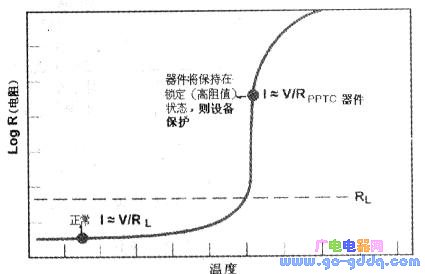The polymer positive temperature coefficient device is a conductive composite composed of a semi-crystalline polymer and conductive particles. At normal operating temperatures, the conductive particles within it form a low-resistance conductive link diagram in the polymer (see the figure below). However, when the temperature rises above the switching temperature (TSE) of the device, the crystals in the polymer melt and form an amorphous material, regardless of whether the heat is from a large current flowing through the device or from an increase in ambient temperature. In this process of melting from the crystal phase, its volume becomes larger, resulting in the separation of conductive particles. And it leads to a large, non-linear increase in device impedance.

As shown in the figure below, the resistance value will increase by three or more orders of magnitude in general. When the resistance value rises, it helps to protect the equipment in the circuit by reducing the current allowed to flow under the fault to a lower steady state level. The device will remain in a locked (high-impedance) state until the fault is removed and the circuit supply is disconnected, at which point the conductive components in the device cool and recrystallize, returning the polymer positive temperature coefficient (PPTC) component to a low resistance state. Next, and the circuit and the affected device are also restored to normal working conditions.

The PolySwitch (self-recovery fuse) LVR device is used to protect the primary and secondary electronic circuits of a linear transformer.
Its LVR technology uses the performance of a proven self-recovering fuse device, but with a higher voltage rating, it can be considered in the design of circuit protection to avoid other costly solutions. In addition to the current limiting capabilities of traditional self-recovery fuse devices, LVR devices protect devices from excessive temperature. This device is therefore suitable for transformer protection, providing overcurrent and overtemperature protection in a single device. Moreover, since the LVR device is capable of resetting itself after a fault event, it is usually not necessary to replace it. These advantages help equipment manufacturers reduce production, warranty, maintenance and repair costs.
When the PPTC of its LVR device family is used in a linear transformer circuit, certain characteristics of the device must be considered.
Choosing the most appropriate device for your application requires an understanding of the temperature-induced rating reduction characteristics. When the ambient temperature line rises by 1 ° C, the average protection current rating will drop by about 1%. This indicates that the actual operating temperature of the transformer should be considered when evaluating the holding current function of the LVR device. The PolySwitch (self-recovering fuse) of the LVR series can reset the rated voltage of the electrical device to 240VAC. It can withstand voltages up to 265VAC and can carry currents from 50 to 400 mA. The package is available in simple circular or rectangular radial leaded devices and is available in a variety of sizes. Some important device parameters are shown in the attached table.

Indicator Meaning: The holding current refers to the maximum steady-state current that can flow through the PolySwitch device under specified conditions without causing the device to operate. The operating current refers to the minimum steady-state current that causes the device to operate when flowing through the PolySwitch device under specified conditions. R1MAX is the maximum resistance of a PolySwitch device after 1 hour at room temperature after operation or after reflow soldering.
SHENZHEN CHONDEKUAI TECHNOLOGY CO.LTD , https://www.szsiheyi.com